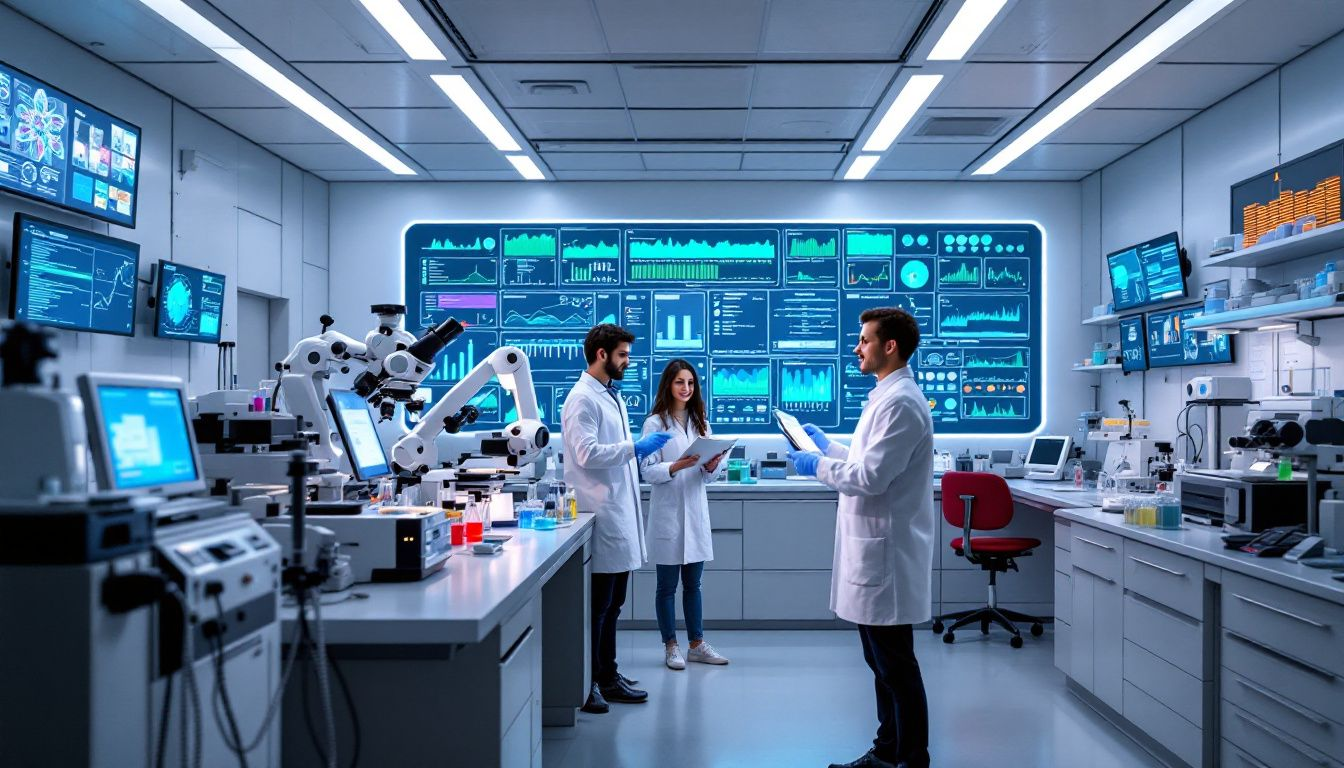What is a Laboratory Information Management System?
A Laboratory Information Management System (LIMS) is a software tool that helps labs manage samples, workflows, and data.
In this article, we will explain what is Laboratory Information Management System, how it works, its key functions, and its benefits.
Key Takeaways
-
A Laboratory Information Management System (LIMS) automates laboratory processes, enhancing workflow efficiency, sample tracking, and data integrity.
-
Key features of modern LIMS include centralized lab data management, automated inventory tracking, and comprehensive compliance tools, ensuring regulatory adherence and reducing manual errors.
-
Successful LIMS implementation necessitates careful planning, stakeholder engagement, and ongoing assessment to adapt to changing laboratory needs and improve operational effectiveness.
Understanding Laboratory Information Management System (LIMS)
.webp?width=654&height=374&name=Understanding%20Laboratory%20Information%20Management%20System%20(LIMS).webp)
A Laboratory Information Management System (LIMS) is an advanced software tool engineered to optimize and govern intricate processes within laboratories.
In contrast to an Electronic Laboratory Notebook (ELN), which is tailored for recording experimental data, the LIMS extends its capabilities to include comprehensive workflow and sample management functions. The system aims at refining lab workflows, managing specimen details, upholding adherence to various standards, and boosting both the integrity and accessibility of data—thus raising laboratory operations’ efficiency and reliability levels significantly. These systems are pivotal in refining such complex procedures.
Essential elements that constitute a LIMS include:
-
Sample tracking: This involves logging essential information like each sample’s identification number, origin point, collection date among other pertinent details. It assures precise handling of samples without misplacement risks.
-
Protocol execution monitoring: This confirms that all laboratory personnel adhere strictly to established protocols yielding uniformity in outcomes.
-
Sample storage organization: A meticulous hierarchy structure maintained by a LIMS ensures efficient location retrieval for any given sample. Thereby fostering better orderliness as well as productivity within lab environments.
By incorporating these features into one cohesive unit, a LIMS elevates overall lab performance while simultaneously minimizing human-induced inaccuracies. For labs tasked with juggling vast numbers of specimens or committed to meeting strict regulatory demands, a reliable information management system like LIMS becomes an indispensable asset supporting day-to-day activities.
Core Functions of LIMS Systems
The fundamental elements of a laboratory information management system are centered around optimizing lab functions and bolstering efficiency. One essential role of LIMS is the management of sample lifecycles, capturing details from their receipt to their progression through various lab processes. Utilization of barcodes for registering samples is commonplace, simplifying tracking procedures and updating patient records.
Centralizing data constitutes another vital aspect of LIMS functionality. By consolidating data within the system, researchers can more efficiently access and scrutinize laboratory information. This advancement negates reliance on paper-based recording methods, improving both accessibility and safeguarding sensitive data. Tailored to meet specific needs, laboratories may opt for storing this centralized database either onsite or via cloud solutions—this versatility Streamlines management practices while ensuring seamless access to critical laboratory figures.
An important feature offered by lims software includes streamlined inventory oversight capabilities. The automation facilitated by such systems notifies personnel about stock quantities as well as impending expiration dates — assisting in maintaining necessary levels of supplies without oversights that might otherwise occur with manual monitoring approaches. In essence, incorporating automated routines into daily tasks through these sophisticated systems not only amplifies operational efficacy but also minimizes human errors—thus promoting improved synergy among members within the lab team.
Enhancing Data Integrity with LIMS Software
Maintaining data integrity is a fundamental aspect of laboratory operations, and the utilization of Laboratory Information Management Systems (LIMS) plays a crucial role in upholding it. Adhering to the ALCOA principles—Attributable, Legible, Contemporary, Original, Accurate—is critical for preserving the trustworthiness of laboratory data. LIMS facilitates this by creating thorough audit trails that associate each piece of data with specific individuals and precise timestamps to promote accountability.
In their efforts to preserve the sanctity of lab data records, LIMS platforms employ robust version control mechanisms and expansive audit trails essential for monitoring modifications made to datasets. These features are vital during compliance audits. They also incorporate security protocols such as encryption and regulated user access permissions which ensure that sensitive information remains accessible solely by approved personnel. These measures taken by LIMS contribute significantly towards safeguarding originality in stored information while deterring unauthorized changes.
When integrated directly with lab equipment, LIMS enable direct capture of experimental results minimizing human transcription errors thus bolstering accuracy in recorded observations. This feature ensures automatic transmission from instruments maintains dependable records necessary across clinical trials’ lifespans. By solidifying all aspects contributing toward absolute adherence to regulatory mandates through heightened precision provided via automated systems integration among other means within labs—it’s evident that leveraging a LIMS can substantially elevate overall research fidelity standards.
Streamlining Laboratory Operations

LIMS provides a wealth of advantages, such as enhanced sample management processes, a decrease in manual mistakes, elevated compliance with regulatory norms, augmented data protection, and superior decision-making capabilities facilitated by immediate access to data and analytics. The conjunction with ELN and SDMS curtails the need for manual data movement, which lowers the likelihood of errors while boosting operational efficiency. Read more: LIMS vs ELNs
By cutting down on clerical duties and optimizing the handling of data, this unification fosters innovation in research activities. Access to real-time information through LIMS allows for quick decisions and modifications amidst the evolving stages of clinical trials.
Sample Tracking and Management
A Laboratory Information Management System (LIMS) is an essential component for exhaustive laboratory data management and sample tracking, enabling scientists to oversee their samples from inception to conclusion. The system must be tailored specifically to handle various sample types, like proteins and cell cultures, in order to maintain precise monitoring. LIMS excels at organizing numerous samples efficiently by recording their storage details and simplifying the retrieval process across all stages of analysis.
By providing a unified platform for trial information within a LIMS, it assures that every involved party has access to up-to-date and consistent data. This centralization of data management plays a pivotal role in keeping records exact while enhancing lab productivity through fostering more informed decisions and teamwork among collaborators.
Workflow Automation and Management
Essential for boosting laboratory efficiency, LIMS software plays a pivotal role by automating regular tasks and refining the management of data. By automating workflows, it ensures uniform sample processing and bolsters efficiency throughout diverse lab activities. The streamlining effect of LIMS on laboratory operations is achieved through reducing manual input of data and connecting related entities within the system, which in turn reduces the likelihood of human error.
The flexibility of a configurable LIMS lies in its swift implementation and ease with which workflow processes, data fields, and report templates can be modified to improve operational efficacy. The automation provided by such systems enables lab staff to devote more attention to important trial elements rather than routine procedures, thereby enhancing both productivity levels across laboratories significantly.
Inventory and Storage Management
LIMS solutions facilitate the organization of inventory management by offering a unified point for accessing information regarding chemical inventories and their respective storage areas. This consolidation simplifies the process of managing inventory amidst diverse storage environments, ensuring that laboratory stock levels are properly sustained. LIMS monitors batch numbers and expiration dates of reagents to enhance reagent administration and diminish the chances of utilizing materials beyond their use-by date.
By documenting where reagents are stored through LIMS, it guarantees swift access to supplies, which is essential in preserving both operational efficiency and adherence to regulatory standards. Such meticulous attention to inventory control is indispensable for bustling laboratories tasked with processing large volumes of data and substances on a daily basis.
Integration with Other Systems
Contemporary LIMS platforms are crafted to ensure smooth interoperability with various systems such as ERP, PCS, SDMS, and ELN. This harmonization fosters a cohesive workflow and the exchange of data between laboratory functions and broader business processes. Such integration propels operational flexibility by supporting laboratories in automating their workflows and amalgamating data, which leads to reductions in costs along with enhanced efficacy.
The incorporation of integrated systems offers capabilities for real-time monitoring that expedites decision-making processes and provides opportunities for swift alterations in research methodologies. An extensive audit trail is preserved throughout these connected systems simplifying adherence to regulatory requirements within the realm of laboratory operations.
By synchronizing LIMS with electronic data capture mechanisms during clinical trials, there’s promotion of uniformity while simultaneously mitigating mistakes related to transferring information.
Regulatory Compliance and Quality Control
LIMS comes equipped with functionalities like compliance checks, electronic signatures, and audit trails. These help laboratories maintain conformity to the most current industry regulations and minimize the chance of non-compliance. Such features are indispensable for labs in regulated sectors where complying with norms including ISO 17025, GCP, GLP, and FDA’s 21 CFR Part 11 is compulsory.
To ensure adherence to these standards, LIMS offers quality control capabilities such as automated reporting and real-time monitoring. It streamlines tasks like proficiency testing and instrument calibration through automation—thereby upholding superior laboratory standards while expediting approval workflows. The integration of these tools is vital for laboratories committed to sustaining top-tier quality assurance and regulatory compliance levels.
Customization and Scalability
Each laboratory operates with its own set of unique processes and demands, making it essential for LIMS (Laboratory Information Management Systems) solutions to be versatile enough to align with the specific needs of each operation. Labs can choose customizable LIMS that permit changes directly in the source code to address particular requirements or opt for configurable LIMS where adjustments are made through pre-existing options without any modification of the underlying code. This capability for personalization ensures labs can devise workflows and reports that precisely cater to the diverse necessities posed by individual clinical trials.
The scalability feature in LIMS is crucial as it enables laboratories to effortlessly adapt to changing circumstances, such as incorporating novel testing techniques or scaling up their activities. Regardless of whether a lab has to handle immense quantities of sample data or intricate test procedures, these systems are engineered not only to meet current operational capacities but also expand alongside your lab’s growth.
Benefits for Different Types of Laboratories

LIMS provides a range of advantages tailored to various laboratory environments. Research labs benefit from improved data accessibility and the ease of sharing research findings, as integration fosters teamwork on a shared platform. This connectivity also guarantees that information is regularly refreshed and immediately accessible for analysis and reporting purposes.
In clinical lab settings, LIMS offers potent security mechanisms to safeguard delicate clinical information using encryption and precise user access restrictions, maintaining adherence to regulatory requirements. The thorough sample tracking capabilities extend from collection through disposal, minimizing the chance of errors or misplacements in clinical trial samples and thereby boosting overall laboratory efficiency.
Key Features of Modern LIMS Solutions

Contemporary LIMS platforms are equipped with various essential functionalities that aim to improve the efficiency of laboratory operations. Solutions based on cloud technology offer persistent data storage, which protects all laboratory-related information from potential disaster or unauthorized access losses. The use of a cloud-based system offers improved accessibility, cost-effectiveness, and automatic updates, facilitating laboratories in maintaining pace with ongoing technological evolutions.
The feature of mobile access provides lab staff the convenience to view patient data gathered through remote means, thus increasing their flexibility and enhancing overall productivity. By aggregating all data into one unified system, these modern systems significantly bolster advanced analytical capabilities and reporting comprehensiveness.
With sophisticated features for analytics and reporting at their disposal, laboratories can now effortlessly discern patterns within collected data and tailor reports according to specific requirements—this empowers informed decision-making based on lab test results.
Successful LIMS Implementation

Implementing a LIMS successfully necessitates meticulous preparation and careful implementation. To gain support for the project, it is essential to involve all necessary parties, which includes both laboratory staff and management personnel. Instructing select individuals who will then disseminate their knowledge to other lab members ensures an effective transfer of expertise as well as a solid grasp of how the LIMS pertains to their context.
Adopting a gradual approach when deploying the LIMS fosters initial acclimation while soliciting user input that can improve how well the system aligns with laboratory requirements. Validating software is crucial in confirming that the LIMS performs seamlessly within existing lab processes and adheres strictly to industry standards and regulations. It’s critical also to carry out user acceptance testing to establish whether or lessions learned are robust under real operational circumstances.
Post-implementation, there must be an ongoing evaluation of the aims capabilities relative to potential improvements becomes apparent for continuous adaptation too evolutions in workflows enable labs to exploit document control functionalities by effectively managing Corrective actions Preventative Action (CAPAs) this helps address any disparities encountered during use.
Summary
Navigating the realm of Laboratory Information Management Systems (LIMS) underscores their critical function within contemporary labs. LIMS serve as a fundamental support in sample management, bolstering data integrity, optimizing workflow processes, and upholding adherence to regulatory standards. The adaptability of these systems for integration with additional platforms, along with their capacity to be customized and expanded upon, render them an essential asset for any lab setting.
As laboratory environments progress technologically, integrating a LIMS becomes vital not only for enhancing operational efficacy, but also as a stepping stone towards scientific breakthroughs. Laboratories that leverage the sophisticated features offered by a LIMS can concentrate on what is paramount: pioneering research and discoveries.
If you've enjoyed this guide, check out our guide on LIMS Full Form in a Laboratory.
Frequently Asked Questions
What is LMS in a laboratory?
LMS, or Laboratory Management System, is a software solution that enhances laboratory operations by streamlining processes, improving productivity, and ensuring quality control.
It often includes features that support various aspects of laboratory management.
What are the four core functions of a lims system?
A LIMS system primarily performs four essential functions: sample management, workflow automation, data management, and quality control and assurance.
These functions are vital for enhancing laboratory efficiency and accuracy.
How does LIMS enhance regulatory compliance?
LIMS enhances regulatory compliance by providing essential features such as audit trails, electronic signatures, and compliance checks, which help laboratories adhere to industry regulations and reduce the risk of non-compliance.
This ensures that organizations maintain high standards in their operations.
What benefits does LIMS offer to laboratory operations?
LIMS significantly enhances laboratory operations by streamlining sample management and reducing manual errors. Additionally, it improves compliance with regulatory standards, enhances data security, and supports better decision-making through real-time data and analytics.
How does LIMS integrate with other laboratory and business systems?
LIMS seamlessly interacts with a range of software, including ERP, PCS, SDMS, and ELN software. This integration fosters an optimized workflow and facilitates the smooth transfer of data between lab operations and business functions.
The result of this synergy is improved productivity and better-informed decision-making processes due to the efficient exchange of information.
Share this
You May Also Like
These Related Stories

Top Strategies for Effective Laboratory Operations Management

LIMS Software for Small Laboratories


No Comments Yet
Let us know what you think